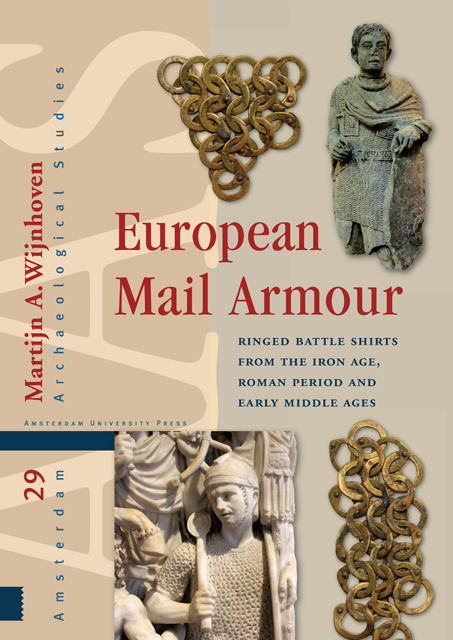Book contents
- Frontmatter
- Contents
- Acknowledgements
- Dedication
- 1 Introduction
- 2 The origins of mail armour
- 3 Distribution and archaeological context
- 4 The iconography of early mail armour
- 5 The naming of mail armour
- 6 Decoration in mail garments
- 7 Padded garments
- 8 The craft of making mail rings
- 9 Weaving patterns
- 10 The construction of mail garments
- 11 Ring characteristics
- 12 Final considerations
- Bibliography
- Database
- Appendix 1 Catalogue of mail armour
- Appendix 2 Catalogue of hybrid armour
- Appendix 3 Catalogue of isolated finds of fasteners and fixtures
- Appendix 4 Finds excluded from the database
Appendix 2 - Catalogue of hybrid armour
Published online by Cambridge University Press: 24 November 2022
- Frontmatter
- Contents
- Acknowledgements
- Dedication
- 1 Introduction
- 2 The origins of mail armour
- 3 Distribution and archaeological context
- 4 The iconography of early mail armour
- 5 The naming of mail armour
- 6 Decoration in mail garments
- 7 Padded garments
- 8 The craft of making mail rings
- 9 Weaving patterns
- 10 The construction of mail garments
- 11 Ring characteristics
- 12 Final considerations
- Bibliography
- Database
- Appendix 1 Catalogue of mail armour
- Appendix 2 Catalogue of hybrid armour
- Appendix 3 Catalogue of isolated finds of fasteners and fixtures
- Appendix 4 Finds excluded from the database
Summary
BULGARIA
Unprovenanced from Bulgaria 3
Date: Roman period. Refined date: end 1st century BC – 2nd century AD.
Description: small fragment of hybrid armour measuring c. 6.5 x 4.5 cm. 4-in-1. Alternating rows of riveted and solid rings. Riveted rings: outer diameter c. 4 mm; inner diameter c. 2.7 mm; overlap clockwise; shape overlap stumpy; small rivet head on one side, the rivets facing the scales are left protruding; cross-section wire round; thickness c. 0.7 mm; width c. 0.7 mm. Solid rings: outer diameter 3.3 mm; inner diameter 2.1 mm; thickness 0.3 mm; width 0.6 mm; conical deformation, burrs. Scales: length 10.8 mm; width top 7 mm; width bottom 5.7 mm; thickness 0.5 mm; 90 degree ledge with holes; mid-rib on outside of scale; tapering towards bottom; straight bottom with rounded corners.
Material: copper alloy.
Remarks: said to have come from Ratiaria. Examined by the author.
Location: privately owned.
Literature: Wijnhoven 2016a, 78-79, fig. 6.
FRANCE
Mandeure
Date: Roman period. Refined date: end 1st century BC - 2nd century AD.
Description: fragment of hybrid armour. 4-in-1. Alternating rows of riveted and solid rings. Rings: diameter c. 3 mm; riveted rings are larger than solid rings. Scales: length 11 mm; width top 8 mm; width bottom 5 mm; 90 degree ledge with holes; mid-rib on outside of scale; tapering towards bottom; straight bottom with rounded corners.
Material: rings: copper alloy; scales: copper alloy covered in white metal.
Location: Musée des Beaux Art et d’Archéologie de Besançon, inv. 855.1.231.
Literature: Bishop 2017, 151; Feugère 1996, 119; Hansen 2003, 59, 169 (C31); Künzl 2002, 140 (cat. no. 6); Matešić 2015, 211; Wijnhoven 2009a, 24-25, 55; 2016a, 79.
GERMANY
Augsburg– Kornhausgasse (fig. 10.23)
Date: Claudian - Neronian.
Context: vicus - timber chest in a layer of burnt soil.
Description: hybrid armour that was rolled up and has corroded together. Current length 26 cm, thickness 11 cm. The majority of the upper part of the armour has been preserved. The garment has been reconstructed through the aid of X-rays at various depths. The coat has two shoulder guards that come from the back to the front. At the front is a small flap that protects the upper chest.
- Type
- Chapter
- Information
- European Mail ArmourRinged Battle Shirts from the Iron Age, Roman Period and Early Middle Ages, pp. 483 - 488Publisher: Amsterdam University PressPrint publication year: 2021



